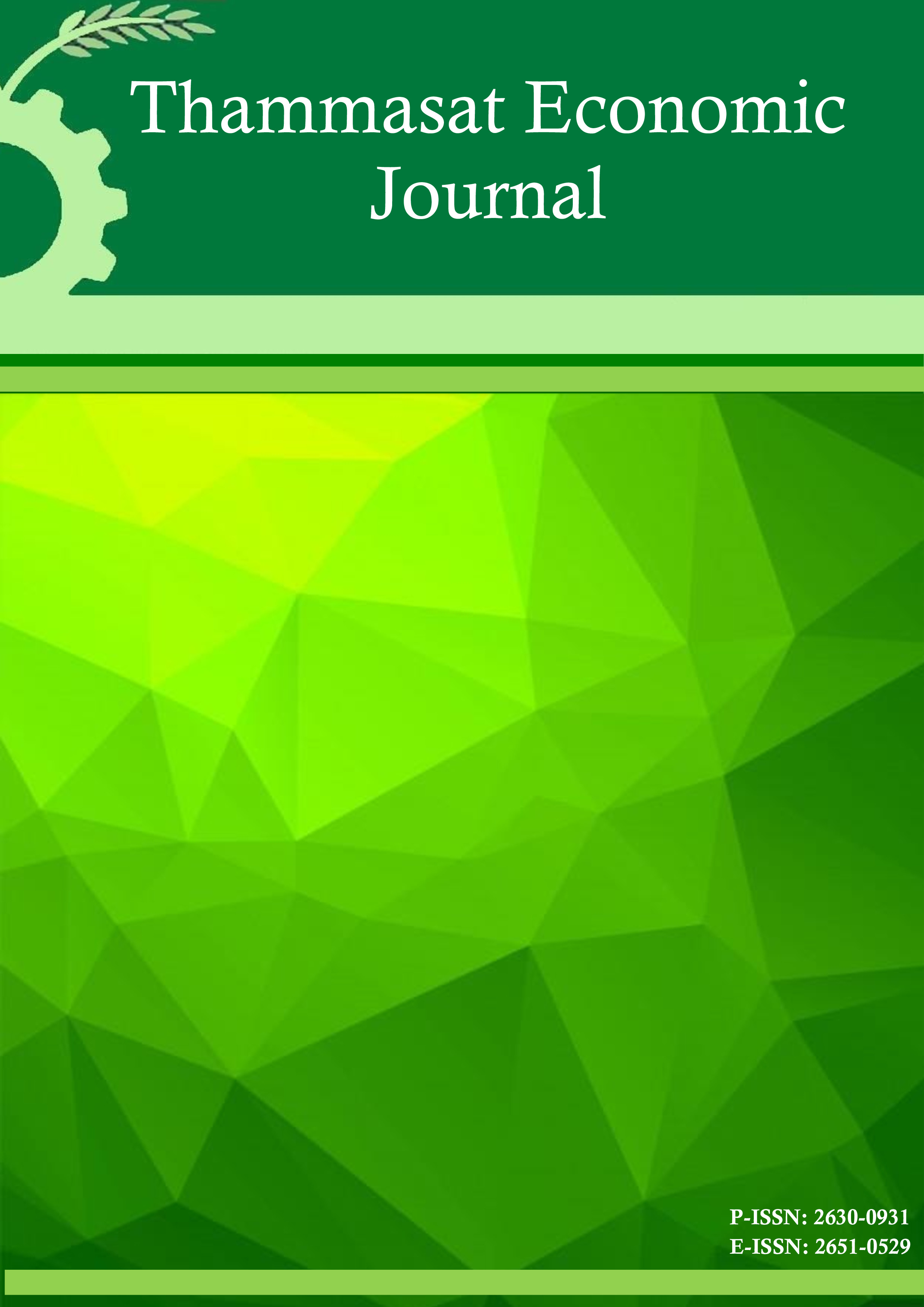อาชญากรรมทางเศรษฐกิจในแบบจำลองการเจริญเติบโต ภายใต้กระบวนการเรียนรู้จากการกระทำ
Abstract
This theoretical paper has extended the “learning by doing” growth model by augmenting a model of economic crime. The major findings are interesting. There is no causality between
economic growth and the size of economic crime since both are endogenous variables. These two variables are affected by two factors-the speed of adjustment in the mechanism of protecting and preventing economic crime and the ratio of economic criminals to the whole population.
A rise in the speed of adjustment will increase economic growth and decrease the size of economic crime. A fall in the ratio of economic criminals to the whole population can increase economic growth as well. However, the impacts of a fall in that ratio on the size of economic crime are unclear. The impacts’ direction depends on the elasticity’s size of economic growth to the ratio. If the elasticity’s size is more than 1, a fall in that ratio is likely to increase the size of economic crime. On the other hand, if the elasticity’s is less than 1, a fall in the ratio of economic criminals to the whole population will decrease the size of economic crime.
References
2. วุฒิพงศ์ เถาวัฒนะ (2544) พาณิชย์อิเล็คทรอนิคส์: ศึกษากรณีกฎหมายป้องกันการทุจริตในการใช้ บัตรเครดิตบนอินเตอร์เนท, วิทยานิพนธ์นิติศาสตร์มหาบัณฑิต. คณะนิติศาสตร์, จุฬาลงกรณ์มหาวิทยาลัย, กรุงเทพมหานคร.
3. ประชาชาติธุรกิจ (30 ม.ค. 2546) การพัฒนากระบวนการยุติธรรมไทยกับ 10 ปีของปัญหาอาชญากรรมทางเศรษฐกิจ. Available at http://www.nidambe11.net/ekonomiz/2003q1/article2003jan30p4.html (accessed 16 May 2006).
4. ประดิษฐ์ คำจร (2544) อาชญากรรมทางเศรษฐกิจ: ศึกษาเฉพาะกรณีเกี่ยวกับการซื้อขายแลกเปลี่ยนเงินตราต่างประเทศกับการบังคับใช้กฎหมาย, วิทยานิพนธ์นิติศาสตร์มหาบัณฑิต. คณะนิติศาสตร์, จุฬาลงกรณ์มหาวิทยาลัย, กรุงเทพมหานคร.
5. อำนาจ เนตยสุภา (2006) อาชญากรรมทางเศรษฐกิจ. Available at http://www.oja.go.th/data/document/news/Economic% 20 Crime.pdf (accessed 17 May 2006).
6. Arrow, K.J. (1962) The economic implications of learning by doing, Review of Economic Studies, 29, pp. 155-173.
7. Atzeni, G.E. & Garboni, O. A. (2005) ICT productivity and firm propensity to innovative investment, EconWPA working papers with number 0503012, Available at http://ideas.repec.org (accessed 1 December 2007).
8. Aghion, P. & Howitt P. (1992) A model of growth through creative destruction, Econometrica, 60(2), pp. 323-351.
9. Baker, W.E. & Faulkner, R.R. (2003) Diffusion of fraud, Criminology, 41(4), pp. 1601-1634.
10. Barro, R. J. & Sala-I-Martin, X. (1995) Economic growth (New York: McGraw-Hill).
11. Barrios, S. & Strobl, E. (2002) Learning by doing and spillovers: Evidence from firm-level panel data, FEDEA working papers with number 2002-09, Available at http://www.fedea.es/eng/009_AcercaDe_ParaQue.asp (accessed 1 December 2007).
12. Bessen, J. (1997) Productivity adjustments and learning-by-doing as human capital, working papers with number 97-17, Center for Economic Studies, U.S. Census Bureau.
13. Bussmann, D. (2003) Causes of economic crime and the impact of values. Paper presented at the
Swiss conference on coping with economic crime: risks and strategies, Swiss-Re, Zurich, November.
14. Grossman, G.M. & Helpman, E. (1991) Innovation and growth in the global economy (Cambridge, MA: MIT Press).
15. Gordon, G.R. & Curtis, G.E. (2000) The growing global threat of economic and cyber crime. Available at http://www.lexisnexis.com/risksolutions/conference/docs/cyber.pdf (accessed 18 May 2006).
16. Holtfreter, K. (2005) Is occupational fraud “typical” white collar crime? A comparison of individual and organizational characteristics, Journal of Criminal Justice, 33, pp. 353-365.
17. Jarmin, R. (1996) Learning by doing and plant characteristics, working papers with number 96-5,
Center for Economic Studies, U.S. Census Bureau.
18. Jones, C.I. (1998) Introduction to Economic Growth (New York: W.W.Norton & Company).
19. Nicola A. D. & Scartezzini A. (2000) When economic crime becomes organized: the role of information technologies, Journal of Institute of criminology, 11(3), pp. 1-5.
20. Nordman, C. & Wolff, F. (2007) On-the-job learning and earnings in Benin, Morocco and Senegal, DIAL working papers with number DT/2007/09, Available at http://ideas.repec.org (accessed 1 December 2007).
21. PricewaterhouseCoopers (2005) the Global Economic Crime Survey 2005 Thailand Report, Available at http://www.pwc.com/crimesurvey (accessed 16 May 2006).
22. Rebelo, S. (1991) Long-run policy analysis and long-run growth, Journal of Political Economy, 99(3), pp.500-521.
23. Romer, P.M. (1986) Increasing returns and long-run growth, Journal of Political Economy, 94(5), pp.1002-1037.
24. Romer, P.M. (1990) Increasing returns and long-run growth, Journal of Political Economy, 98(5), pp. S71-S102.
25. Siebert, R. (2002) Learning by doing and multi production effects over the life cycle: Evidence from the semiconductor industry, CIG working papers with number FS IV 02-23, Available at http://ideas.repec.org (accessed 1 December 2007).
26. Smith, G.R. (2001) Cross-Border economic crime: the agenda for reform. Available at http://www.aic.gov.au/publications/tandi/tandi202.html (accessed 19 May 2006).
27. Solow, R.M. (2000) Growth theory (New York: Oxford University Press).
28. Van Den Berg, H. (2001) Economic Growth and Development (New York: McGraw-Hill/Irwin).










